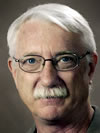 Robert A. Gastaldo |
2016 Gilbert H. Cady Award
Presented to Robert A. Gastaldo
Citation by Jack C. Pashin
It is a pleasure to deliver the citation for this year’s Gilbert H. Cady Award, which goes to Dr. Robert A. Gastaldo of Colby College. Bob received a bachelor’s degree from Gettysburg College and went on to receive masters and doctoral degrees from Southern Illinois University. He joined the faculty of Auburn University in 1978 and was named Alumni Professor of Geology. In 1999, Bob became the Whipple-Coddington Professor of Geology at Colby College.
Bob has had an exceptional career that includes a number of notable achievements as a teacher, a researcher, and in service to our profession. Indeed, Bob served as chair of the Geological Society of America Coal Geology Division from 1991 to 1992. He has served GSA, SEPM (Society for Sedimentary Geology), the Paleontological Society, and the National Science Foundation in many capacities. Highlights of his career include service as co-editor of Palaios and receipt of the SEPM Distinguished Service Award. Bob is a Fulbright Fellow, a GSA Fellow, and a Paleontological Society Centennial Fellow.
Teaching and interacting with students is a real joy to Bob, and he was recognized twice with the Best Teacher Award at Auburn University. Bob’s students have been highly successful, and his collaborators have included too many notable geological luminaries to name here. His research has always been groundbreaking and exemplifies the value of integrating diverse avenues of inquiry to solve research problems. Bob has produced fundamental papers on plant taphonomy and the structure of Carboniferous swamp communities. He has tackled a broad range of geologic problems and is unafraid to challenge long-held geologic concepts. Indeed, his current research on the terrestrial record of the terminal Permian extinction demonstrates that geologic and biological events were much more complex than previously thought. Join me in congratulating Bob Gastaldo, who is more than deserving of this great honor.
 2016 Gilbert H. Cady Award — Response by Robert A. Gastaldo
2016 Gilbert H. Cady Award — Response by Robert A. Gastaldo
Just when chaos seems to prevail at the end of an academic semester, an e-mail arrived from Jen O’Keefe, late in the day before classes ended, with the subject line “Congratulations.” I wasn’t sure, at first, whether I would need to transfer a large sum to a stealth organization or select a Nigerian prince to act as an intermediary before I learned about what the congratulations actually meant. Was I relieved—and humbled—to learn that I had been selected to be the Gilbert H. Cady awardee. My next reaction was similar to former President Clinton when he characterized his phase in life, a stage where there are more yesterdays than tomorrows. But, neither he nor I am looking death in the face. In my case, I’m just pining and wishing I knew then what I know now. Having had opportunities to work in both ancient-and-modern, coal-bearing systems on a global scale, alongside a cadre of insightful, energetic, and talented collaborators, arrayed across a wide disciplinary spectrum, has been reward enough. I truly appreciate being this year’s Cady honoree, and being able to accept the award with the person who has facilitated my flights of national and international fancy.
My wife, Elvira, began splitting Mazon-Creek type nodules in an abandoned coal mine in Carterville, Illinois, shortly after we married. Today, the city has a website; then, most of southern Illinois was a barren wasteland of unreclaimed mines which, fortunately for us, acted as exotic “vacation” hea(l)t(h) spas while living on a graduate-student stipend. During those years, we first met Bill DiMichele, with whom Elvira has let me continue to co-habitat from the Borneo jungles to sketchy waystops in Wyoming, and hotels in former Eastern Europe. Through Bill, Hermann and Barbara Pfefferkorn entered our lives. These decadenal interactions have been rewarded with collaborative projects that increased our discipline’s global perspective of the Carboniferous. These life-long friendships were established before dragging Elvira to ‘Bama, where both coalfield and coastal deltaic swamps coexist.
Alabama offered unlimited possibilities at a time when open-cast mining was near its zenith. I am grateful to my Auburn M.Sc. students, Michael Gibson and Tim Demko, among others, and my first undergraduate research student, Cortland Eble, who toiled away under baking summer sunshine and oppressive heat, losing countless pounds, to detail coal-bearing cycles and helping to place these into the emerging sequence stratigraphic paradigm. It was Jack Pashin at the Alabama Survey with the resources and vision to witness the bigger, basinal patterns, placing our case studies into larger context. With his insight, these concepts were translated to Polish, Czech, and Ukranian basins. Knowing little to no Polish or Czech, nor French or German, Elvira braved onward, accepting the next international sojourn of short or extended-length stays with, or without, three children. This included our year with Walter Riegel in Göttingen, Germany, focused on how deltaic Taxodium swamps compared to Braunkohle deposits of central Europe. And, when only dispersed organic was present, our time in Paris with Alain Huc of IFP, among many other collaborators in many other countries. I apologize that space precludes me from acknowledging these colleagues who have played central roles in my experiences to gain insights into the taphonomies, ecosystems, and sedimentologic conditions under which terrestrial plants become our fossil-fuel resources. I wish I knew then what I know now, when I was younger. Thank you, the Gilbert H. Cady committee, for this honor.
